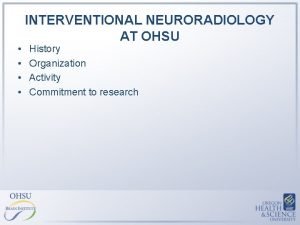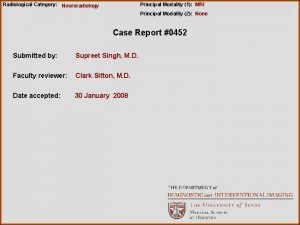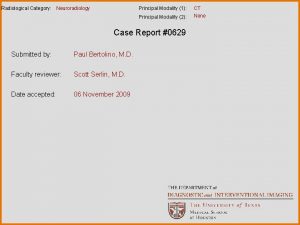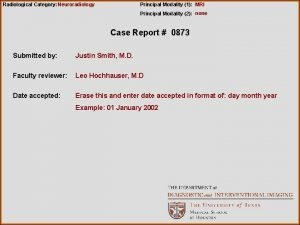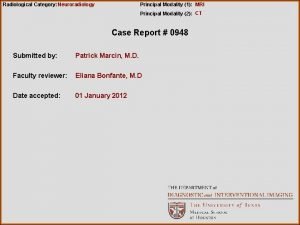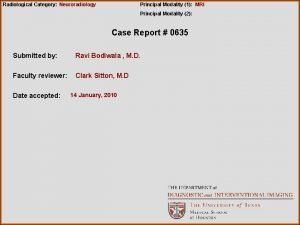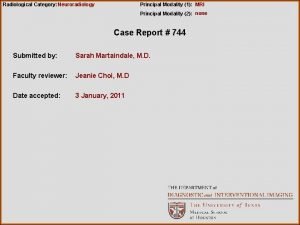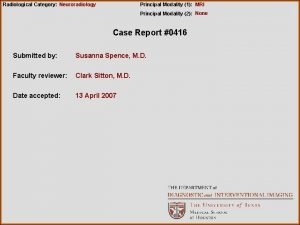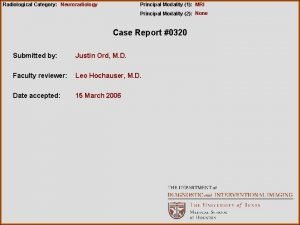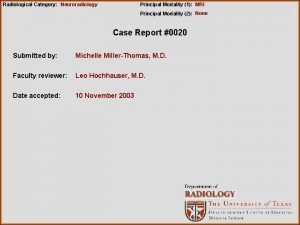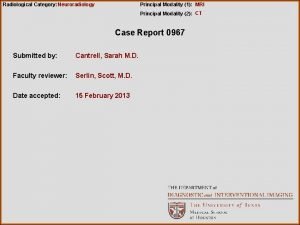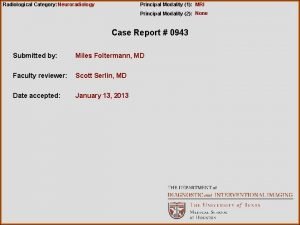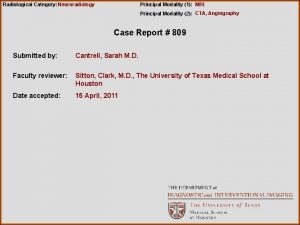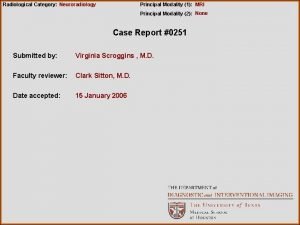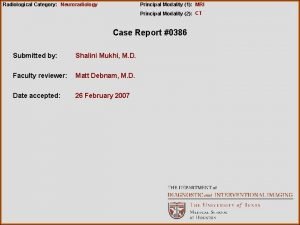Radiological Category Neuroradiology Principal Modality 1 MRI Principal
















- Slides: 16

Radiological Category: Neuroradiology Principal Modality (1): MRI Principal Modality (2): CT Case Report #0527 Submitted by: Andrew Tenn, M. D. Faculty reviewer: Clark Sitton, M. D. Date accepted: 08 May 2008

Case History 35 y/o female with L sided orbital/temporal headache, followed by left ptosis and diplopia.

Radiological Presentations

Radiological Presentations

Radiological Presentations

Radiological Presentations

Radiological Presentations

Radiological Presentations

Radiological Presentations

Test Your Diagnosis Which one of the following is your choice for the appropriate diagnosis? After your selection, go to next page. • Cavernous sinus thrombosis • Perineural tumor spread • meningioma • Carotid aneurysm • Tolosa-Hunt

Additional History The patient’s symptoms improved after a trial of steroids.

Findings and Differentials Findings: Pre and Post contrast T 1 -weighted images demonstrate enhancing soft tissue within the left cavernous sinus, with extension of the enhancement through the left foramen ovale along the 3 rd cranial nerve. The carotid flow voids are normal. The CT image in bone window demonstrates the foramina ovale to be symmetrical and not expanded. Differentials: • Tolosa-Hunt Syndrome • Sarcoid • Meningioma • Perineural spread into cavernous sinus via V 3 • Infection

Discussion Tolosa-Hunt is an idiopathic inflammatory disease of the cavernous sinus. Clinical features include: • steady, gnawing retroorbital pain • CN III, IV, VI, and V 1 neuropathies • Symptoms last days to weeks • Prompt response to high dose steroids Sarcoidosis is known to cause inflammatory masses in the orbital apex which can extend into the cavernous sinus. There is typically systemic sarcoid symptomatology in such cases. In this case, lack of involvement of the orbital apex and no history to support systemic sarcoid make this an unlikely, although plausible, diagnosis.

Discussion Perineural spread of tumor is a good diagnostic consideration for the imaging findings presented. Cranial nerve V 3 is very prone to such involvement. An important finding in perineural tumor spread that is not present is expansion of the foramen ovale. The patient’s age and lack of a primary tumor history also make it a less likely diagnosis. Tumors with particular propensity to spread along nerves include desmoplastic melanoma, adenoid cystic carcinomas, basal and squamous cell carninomas, lymphomas, and schwannomas. Infections that can occasionally present with inflammatory soft tissue in the cavernous sinus include Actinomycosis, Aspergillus, and Mucor. These would not be expected to improve with steroid therapy. Meningiomas of the skull base can present as enhancing masses anywhere in the skull base where there is dura, including the cavernous sinus. Perineural extension is a rare manifestation, and again, response to steroids is not typical unless the lesion is associated with vasogenic edema.

References • Grossman RI, Yousem DM (2003). Neuroradiology: The Requisites, 2 nd Ed. Philadelphia, Elsevier Inc. Lee JH et al. Cavernous Sinus Syndrome: Clinical Features and Differential Diagnosis with MR Imaging. AJR 2003; 181: 583 -590 Nemzek WR et. Al. Perineural Spread of Head and Neck Tumors: How Accurate Is MR Imaging? . AJNR 1998; 19: 701 -706

Diagnosis Tolosa-Hunt Syndrome
 Ohsu neuroradiology
Ohsu neuroradiology Aerohive erate
Aerohive erate Radiological dispersal device
Radiological dispersal device Tennessee division of radiological health
Tennessee division of radiological health Center for devices and radiological health
Center for devices and radiological health National radiological emergency preparedness conference
National radiological emergency preparedness conference Mri principal
Mri principal Modality in software engineering
Modality in software engineering Cardinality and modality
Cardinality and modality Lexical vs auxiliary verbs
Lexical vs auxiliary verbs Skill focus: persuasion
Skill focus: persuasion Epistemic modality
Epistemic modality Monode electrode
Monode electrode Modality in statistics
Modality in statistics Modality microsoft services
Modality microsoft services Sodality vs modality
Sodality vs modality One to many relationship line
One to many relationship line
